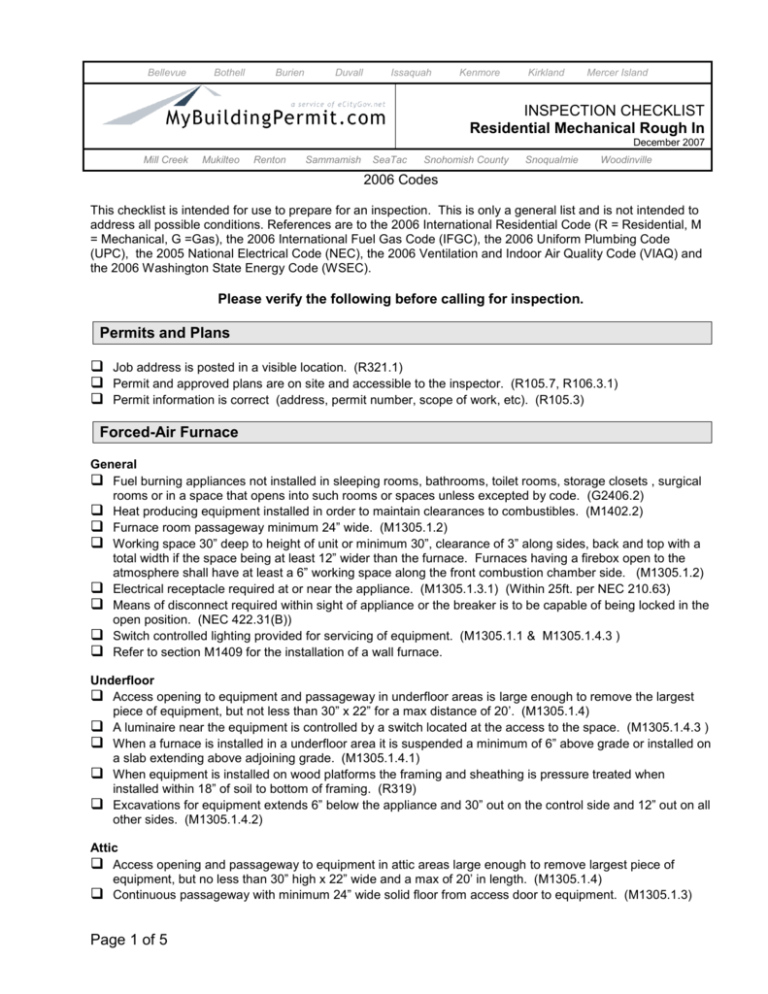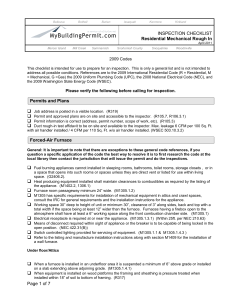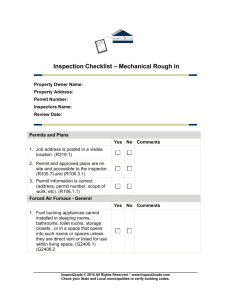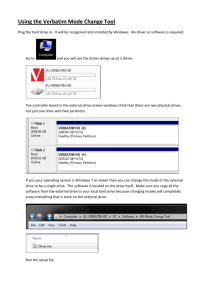Mechanical Rough In Checklist
advertisement

Bellevue Bothell Burien Duvall Issaquah Kenmore Kirkland Mercer Island INSPECTION CHECKLIST Residential Mechanical Rough In December 2007 Mill Creek Mukilteo Renton Sammamish SeaTac Snohomish County Snoqualmie Woodinville 2006 Codes This checklist is intended for use to prepare for an inspection. This is only a general list and is not intended to address all possible conditions. References are to the 2006 International Residential Code (R = Residential, M = Mechanical, G =Gas), the 2006 International Fuel Gas Code (IFGC), the 2006 Uniform Plumbing Code (UPC), the 2005 National Electrical Code (NEC), the 2006 Ventilation and Indoor Air Quality Code (VIAQ) and the 2006 Washington State Energy Code (WSEC). Please verify the following before calling for inspection. Permits and Plans Job address is posted in a visible location. (R321.1) Permit and approved plans are on site and accessible to the inspector. (R105.7, R106.3.1) Permit information is correct (address, permit number, scope of work, etc). (R105.3) Forced-Air Furnace General Fuel burning appliances not installed in sleeping rooms, bathrooms, toilet rooms, storage closets , surgical rooms or in a space that opens into such rooms or spaces unless excepted by code. (G2406.2) Heat producing equipment installed in order to maintain clearances to combustibles. (M1402.2) Furnace room passageway minimum 24” wide. (M1305.1.2) Working space 30” deep to height of unit or minimum 30”, clearance of 3” along sides, back and top with a total width if the space being at least 12” wider than the furnace. Furnaces having a firebox open to the atmosphere shall have at least a 6” working space along the front combustion chamber side. (M1305.1.2) Electrical receptacle required at or near the appliance. (M1305.1.3.1) (Within 25ft. per NEC 210.63) Means of disconnect required within sight of appliance or the breaker is to be capable of being locked in the open position. (NEC 422.31(B)) Switch controlled lighting provided for servicing of equipment. (M1305.1.1 & M1305.1.4.3 ) Refer to section M1409 for the installation of a wall furnace. Underfloor Access opening to equipment and passageway in underfloor areas is large enough to remove the largest piece of equipment, but not less than 30” x 22” for a max distance of 20’. (M1305.1.4) A luminaire near the equipment is controlled by a switch located at the access to the space. (M1305.1.4.3 ) When a furnace is installed in a underfloor area it is suspended a minimum of 6” above grade or installed on a slab extending above adjoining grade. (M1305.1.4.1) When equipment is installed on wood platforms the framing and sheathing is pressure treated when installed within 18” of soil to bottom of framing. (R319) Excavations for equipment extends 6” below the appliance and 30” out on the control side and 12” out on all other sides. (M1305.1.4.2) Attic Access opening and passageway to equipment in attic areas large enough to remove largest piece of equipment, but no less than 30” high x 22” wide and a max of 20’ in length. (M1305.1.4) Continuous passageway with minimum 24” wide solid floor from access door to equipment. (M1305.1.3) Page 1 of 5 Minimum 30” deep platform in front of service side of equipment except where serviceable directly from the access. (M1305.1.3) Garage Equipment which has a flame, generates a spark or uses a glowing ignition source is open to the space in which it is installed and is elevated such that the source of ignition is at least 18” above the floor. (M1307.3) Ducts which penetrate a wall or ceiling separating the garage from the dwelling are 26 gage with no openings to the garage. (R309.1.1) Bollard or wheel stop required if subject to impact by automobile. (M1307.3.1) Condensing Furnace (High Efficiency) Condensate drain required to drain by gravity to an approved drain or condensate pump. (M1411.3) Drain pipe minimum 3/4” with 1/8”/ft. slope. (Per manufacturer’s installation instructions) May drain to indirect receptor (lav tailpiece, tub over flow, etc.). (Per manufacturer’s installation instructions) Ducting General Two story maximum vertical rise on factory made duct. (M607.6.1) Duct to ground minimum 4” clearance. (M1601.3.6) Duct in or under concrete, encased in a minimum 2” of concrete. (M1601.1.2) Round ducts have crimped joints lapped minimum 1½” and fastened with (3) sheet-metal screws or rivets equally spaced around the joint. (M1601.3.1) Joints, seams, and fittings of ducts sealed with tapes, mastic or other approved means. (UL-181 tape). (M1601.3.1 & WSEC 503.10.2) Ducting (including enclosed stud bays or joist cavities used to transport air), installed outside the conditioned space have all seams and joints, both longitudinal and transverse, sealed. (M1601.3.1 & WSEC 503.10.2) Flex duct supported per manufacturer’s specifications. (M1601.3.2) Metal duct minimum support every 10’. (M1601.3.2) Return Air Return air taken from a room or space >25% of the total volume served. (M1602.2, item 3) Can’t be taken from bathroom, kitchen, toilet room, mechanical room, closet, furnace room, other dwelling unit, or garage. (M1602.2) Return air inlets not located within 10’ of any fuel burning appliance fire box or draft hood located in the same space. (M1602.2, item 5, exception 3) Minimum return air duct size is 2 sq.in./kBtu output rating of the furnace or as otherwise specified by the manufacturer. (G2442.2) Insulation Ducts, boots and connectors used for heating or cooling insulated to R-8 in unconditioned spaces and to R5 in cement slabs or in ground. (WSEC Tbl. 5-11) Ducting installed in cold walls insulated to R-8. (WSEC Tbl. 5-11, note 1) Exhaust ventilation ducting insulated to R-4. (VIAQ 302.2.3 & 303.3.4) Combustion Air Ducting in cold walls insulated to R-8. (WSEC Table 5-11 note 1) The minimum cross section dimension for rectangular combustion air ducting is 3” and 3-1/2” for round ducting. (M1703.2.1) Dampers are not allowed in combustion air ducts. (M1701.3) Combustion air is not allowed to come from sleeping rooms, bathrooms or toilet rooms. (M1701.4) Sources of combustion air > 10’ from return air. (M1602) Page 2 of 5 Opening sleeved to 6” above ceiling joists and insulation. (M1703.3 & G2407.11) Ducts cannot be screened when terminating in an attic space. (M1703.3, item 4) When combustion air is obtained from the attic the attic must be sufficiently vented. (M1703.3, item 1) In buildings of unusually tight construction, combustion air shall be obtained from outside the building. (M1701.1.1) Each opening shall be 1 sq. in. per 1,000 Btu/h input of all appliances, but not less than minimum of 100 square inches per opening for appliances in a confined space. (M1702.2) Only the lower of the 2 combustion air openings can be connected to an under floor area. (M1703.4) Foundation vents supplying underfloor area are to be minimum 2 times the required combustion air opening. (M1703.4) Where vertical ducts are used each opening requires 1 sq. in. of opening per 4,000 Btu/h of total input rating of all appliances in the space. (M1703.2.1) Where horizontal ducts are used each opening requires 1 sq. in. of opening per 2,000 Btu/h of total input rating of all appliances in the space. (M1703.2.1) When the one opening method is used the opening requires 1 sq. in. of opening per 3,000 Btu/h of total input rating of all appliances in the space and be within the top 12” of the space. (G2407.6.2) Outside combustion air openings are to be screened with ¼ to ½ inch mesh corrosion-resistant material. (M1703.5) Combustion air may be drawn from inside the building if of ordinary tightness and the conditioned space is greater than 50 cubic feet per 1,000 Btu/h input for all fuel burning appliances combined. (M1701.1.1) Vents and Connectors Venting systems are to be adequately supported for the weight of the material used. (M1801.7, G2427.5.7) Where two gas appliances are vented through a common vent connector it is equal to largest connector plus 50% of the smaller flue outlet and not less than the combined area of the flue outlets for which it acts as a common connector. (G2427.10.3.4, IFGC 503.10.3.4, IMC 803.3) Gas vents over 12” in diameter or are located less than 8’ from a vertical wall or similar obstruction, terminate 2’ above any portion of a building within 10’ horizontally. (G2427.6.5 item 2, IFGC 503.6.4) Gas vents 12” in size or smaller and are not less than 8’ from a vertical wall or similar obstruction terminates a minimum of 12” from roofs when 6/12 or flatter. See Tbl. 8-A for other. (G2727.6.4, IFGC 503.6.4) Vent connector clearances to combustibles per manufacturer’s listing or performance standards. (M1803.3.4, M1306.2, G2427.7.7) Single wall vents cannot penetrate a wall, floor or ceiling without a listed pass through assembly. (M1803.3.1, G2427.7.5) Vent terminations installed per the manufacturer’s listing. (M1804.2.1) Venting terminations for power venting and direct venting shall not less than 4’ below or 4’ horizontally from, and not less than 1’ above a door, an operable window or a gravity air inlet into a building, nor less than 3’ above any forced air intake within 10’, nor within 12” of grade. (M1804.2.,6 items 1 through 7, G2427.8) (IRC appendix C) (IFGC 503.8, & appendix D) (See also IMC 804.3.1 through 804.3.7) (M1804.2.6 & G2427.8 ) Vent terminal not mounted directly above or within 3’ horizontally of a gas meter or oil tank. (M1804.2.6) Vent terminal no closer than 3’ to an interior corner formed by (2) perpendicular walls. (M1804.2.6) Power exhaust terminals not located within 10’ of property line and adjacent buildings. (M1804.2.6) Where vents extending into an attic pass through insulated assemblies, an insulation shield of 26 gage sleeve not less than 2 inches above the insulation, secured in place and maintain required clearances to combustibles. (G2426.4, IFGC 502.4) Venting supported per manufacturer’s listing. (M1803.3 & G2427.5.7) Vent connector joints are fastened with sheet metal screws or rivets. (M1803.3) Vent and chimney connectors installed within the same space that the appliance is located. (M1803.3) Appliances Clothes Dryer Install appliances per manufacturer’s instructions. (M1307.1 & G2408.1, IFGC 305.1) IMC 504 ) Page 3 of 5 Clothes dryer exhaust ducts of metal with smooth interior surfaces, with joints running in the direction of air flow. (M1501.1 & G2439.5) Connector not concealed in construction. (M1501.1 & G2439.5) No screws used to attach connector to duct. (M1501.1 & G2439.3) Duct connector 4” minimum or appliance outlet size. (M1502.3, G2439.5) Exhaust duct doesn’t exceed 25’. Deduct 2.5’ for each 45-degree elbow and 5’ for each 90-degree bend. (See also manufacturer’s installation instructions when make and model of dryer are known at rough in.) (M1502.6 & exception & G2439.5.1 & exception) Clothes dryer ducting run independently of other ducted systems. (M1502.2 & G2439.1) Exterior termination is backdraft damper with no screens. (M1502.2) Dryer duct connector maximum 8’ long. (M1502.4, G2439.5) Gas dryer gas connectors maximum 6’ long. (G2422.1.2.1) Gas connectors are not concealed within, or extend through walls, floors, partitions, ceilings or appliance housing. (G2422.1.2.3) Shutoff valve installed immediately ahead of connector. (G2422.1.2.4) Range Vertical clearance to combustibles is 30” minimum or per manufacturer’s listing. (M1901.1) Gas connector maximum 6’ long. (G2422.1.2.1) Shutoff valve installed immediately ahead of connector. (G2422.1.2.4) Range Hood Duct Terminates outside, is air tight and is equipped with a backdraft damper. (M1503.1) Ducting is galvanized steel, stainless steel, or copper, with a smooth interior. (M1503.2) Fireplace Factory built fireplaces listed and labeled. (R1004.1 Hearth extensions are to be readily distinguishable from the surrounding floor and in accordance with the fireplace listing. (R1004.2) Installed per manufacturer’s installation instructions when installed in a solid fuel burning fireplace. (G2432.1) Penetrations sealed with listed materials. (G2432.1) Factory built chimney requires spark arrester. (G2727.6.6, R1003.9.1) Shutoff valve located in fireplace firebox installed per the appliance manufacturer’s instructions. (G2420.5.1) Decorative shrouds used at chimney terminations are to be listed and labeled for use with specific chimney system. (R1004.3, R1005.2) Air-Conditioning Cooling coils installed downstream (return side) from heat exchanger. (M1411.2) Working space minimum 30” x 30”. (M1305.1) Condensate line to an approved place of disposal, but not to public way. (M1411.3) Condensate line minimum 3/4” and sloped to drain termination without sags. (M1411.3.2 & UPC 814.1) Refrigerant lines are to be pressure tested prior to start up of the compressor. (IMC 1108.1) Exhaust Venting Source specific ventilation fans are required in kitchens, bathrooms, water closet rooms, laundry rooms and indoor swimming pools or spas. (VIAQ 302.2.1) Bathroom fans 50 cfm minimum. (VIAQ Tbl 3-1) Kitchen fans 100 cfm minimum. (VIAQ Tbl 3-1) All exhaust ducts terminate outside the building, are equipped with back draft dampers and insulated to a minimum of R-4 in unconditioned spaces such as attics and crawlspaces. (VIAQ 303.4.1 & 303.4.2.3) Whole house ventilation systems Page 4 of 5 Intermittent Whole House ventilation using Exhaust Fans (VIAQ 303.4.1) Whole house fan located < 4’ from the interior grille have a sone rating on fan 1.5 or less. (VIAQ 303.4.1.2) Remotely mounted fans are to be acoustically isolated from structural elements and solid duct work. (VIAQ 303.4.1) A readily accessible 24 hr timer, set to operated 8 hours /day and tied to exhaust fan. ( VIAQ Table 3-2 for ventilation rate of fan in CFM) (VIAQ 303.4.1.3) Label affixed to controls: “Whole House Ventilation. (See operating instructions)”. (VIAQ 303.4.1.3) Outdoor air inlets not less than 4 sq.in. in each habitable room. (VIAQ 303.4.1.5, item C) Doors undercut minimum 1/2” where separated from exhaust source. Exception: Exhaust only ventilation systems do not require outdoor air inlets if the home has a ducted forced air heating system that communicates with all habitable rooms and the interior doors are undercut to a minimum of 1/2” above finish floor covering. (VIAQ 303.4.1.5) Whole House Ventilation Integrated with Forced Air System (VIAQ 303.4.2) Screened outdoor air inlet to return air plenum with motorized damper. Outdoor air inlet duct connection to the return air stream located within 4’ upstream of the forced-air blower. A readily accessible 24 hour timer, set to operated 8 hours /day and tied in to furnace blower and motorized damper. Label affixed to control: “Whole House Ventilation (See operating instructions)”. Intermittent Whole House Ventilation Using Supply Fan (VIAQ 303.4.3) Uses inline supply fan. Outdoor air must be filtered before it is delivered to habitable rooms. Outdoor inlet located downstream of blower when connected to the supply side. Outdoor inlet minimum 4’ upstream when connected to the return side. A readily a readily a readily accessible 24 hour timer, set to operated 8 hours /day and tied in to the inline supply fan. Label affixed to control: “Whole House Ventilation (See operating instructions)”. Whole House Ventilation Using a Heat Recovery Ventilation System (VIAQ 303.4.4) All ducts must be minimum 6” diameter. Balancing dampers are installed on the inlet and exhaust side. Supply ducts in conditioned space upstream of the heat exchanger insulated to minimum R4. A readily accessible 24 hour timer, set to operated 8 hours /day and tied in to the inline supply fan. Label affixed to control: “Whole House Ventilation (See operating Instruction)”. Outdoor Air Inlets (VIAQ 303.4.4.4) Inlets are screened. Inlets located so as not to draw air from any of the following locations: a) Within 10’ of an appliance vent outlet, unless such vent outlet is 3’ above the outdoor air inlet. b) Where it will pick up objectionable odors, fumes or flammable vapors. c) A hazardous or unsanitary location. d) A room or space having any fuel burning appliances therein. e) Within 10’ of a vent opening for a plumbing drainage system unless the vent opening is at least 3’ above the air inlet. f) Attic, crawl spaces or garages. Page 5 of 5









